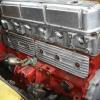My Tip - Twin coils easy as 1-2-3
#76

Posted 05 March 2009 - 08:50 AM
#77

Posted 05 March 2009 - 11:17 AM
Was this latest effort just using the conventional points setup, with original resistance wire powering both coils etc?
Yes.
#78
 _torbirdie_
_torbirdie_
Posted 05 March 2009 - 11:35 AM
Did doing that achieve anything in the past. I would anticipate that the effect, however,it works would be minimal as the effective voltage available to both coils and the saturation current in both coils would drop due to the action of the resistor wireYes.
. From memory the resistor wire is about 1.5ohms and standard coil about 2ohms, which puts the saturation current through the coil at ~4A and a voltage of ~8V across the coil when the points are closed with the engine running and producing 14V.
With another coil in parallel, the saturation current through each coil would only be 2.8A with a voltage of 5.6V across each coil, worse off than a single coil, but with whatever action happens through the two coils being connected the overall effect may be enhanced.
#79

Posted 05 March 2009 - 06:26 PM
As i said..the only way i think it will make a difference will be to put it back on the EH...but even then YT head and cam are gone...just a stock 202 with the gas gear on it now...but I think gas was the reason for the change in idle speed...I know the 425 runs very rich and I am confident that an increase in spark voltage caused it to pick up.
Edited by FastEHHolden, 05 March 2009 - 06:27 PM.
#80

Posted 05 March 2009 - 08:44 PM
With two primaries connected in parallel you need twice the current in the circuit (logical right?) this means twice the power (P=VI) that is Power equals Volts by Current.
You can't destroy energy.
When the transistor (this was originally about HEI) switches off (or points open) there is a sudden collapse of the magnetic fields in both coils inducing a rising voltage into both the primaries and the secondaries, as the one with the plug connected actually sparks it acts as though there is a short circuit on the secondary secondary current flows .
This means that the primary of this firing coil looses any inductance it did have and wants to drop immediately to zero volts (it basically stuffs all its energy into the seconday current).
As the second parallel coil hasnt fired the energy stored in its field produces a current in the primary of the firing coil. (the primary at this time has a voltage of several hundred volts across it and sees the short circuit on the primary of the firing coil).
This primary current from the second coil into the firing coil causes the spark time to be lengthened giving a hotter spark and thus probably better combustion under some circumstances. (Apparently it can improve the burn rate because it lights up more of the swirling gas in the cylinder giving a better wave front this gets a bit esoteric and I really cant be stuffed following it up I believe them)
Theory says that if both coils are the same you will get at most 1 - 1/2 times theoriginal spark power. the other is dissipated in the windings of the two coils resistance.
This is a simplified version as there is actually a lot more going on as far as the theorry goes. (heavy Maths )
the voltage across the secondary of the second coil should, if the same coils are used, not be higher than the secondary voltage of the firing coil..
All I can say is SORRY fellas i didn't believe it originally but thanks, I have learnt a lot from this (including how much simplistic bullshit exists on the internet about auto ignition).
Theoretically it does make sense.
however there are still downsides.
Whether you are using HEI or points you need to provide twice the rated current through the points or the main transistor. This will shorten the life of either of these devices.
the firing coil will get hotter, Plugs will take a beating! wiring will get hotter. Points will burn out quicker.
HEI modules may be taken beyond their safe ratings and fail quicker.
If your ignition system is up to scratch for your comp ratio and fuel type /mixture then the only difference should be noticed at high revs due to the faster time constant. (the higher the comp ratio the hotter the spark needs to be to fire it)
you could probably get the same result by bypassing the ballast resistor and run the resistive coil at full battery volts.
all in all a good learning exercise when I get the time I may just set up a system and do some experimentation and see exactly what the gains are in the electrical sense.
#81
 _torbirdie_
_torbirdie_
Posted 05 March 2009 - 08:45 PM
Fasteh: Possilby if you increased the plug gap to the point of misfiring on the premier, then connected the 2nd coil, then if there was a difference then it would stop the misfires.
However, the effect as initially described is to benefit the systems ability to build up charge when the rpm gets higher, not produce a bigger spark at idle, perhaps it does both.
Edited by torbirdie, 05 March 2009 - 08:50 PM.
#82

Posted 05 March 2009 - 09:17 PM
This theory gives the reason for the apparent benifit at low revs. both apply!
Consensus reached was that it will make the gains when the original ignition is not up to firing the mixture fully.
You will always get the rise time benefit but it really only affects higher rev ranges. (thus the use in the Jag V12)
So for the VOLVO (Arghh) it probably had a crappy ignition system (matching the car in my opinion)(please guys its my opinion don't throw buns Please!!).
for the Eh comp ratio and mixture coupled with gas as a fuel probably lit up better with this system.
The f@@D in the article probably higher comp ratio, rich mixture, lit up better.
#83

Posted 06 March 2009 - 07:44 AM
As for FastEH, i reckon that the 'hotter' spark would cause the gas to ignite better.
I think i'll have to try another old coil in parallel with the 202 kingswood on gas!
But do agree that removing the ballast resistor or resistance wire would produce the same affect. (in points system).
Cheers
Mike
#84

Posted 06 March 2009 - 09:33 AM
#85
 _NZ Toranaman_
_NZ Toranaman_
Posted 06 March 2009 - 10:16 AM
I now have one question, I run a hot wire from battery to key to coil which produces 13.8volts at the coil, does the Electronic ignition run 12volt or 13.8volt?
Thanks
Graham
#86

Posted 06 March 2009 - 10:43 AM
#87
 _NZ Toranaman_
_NZ Toranaman_
Posted 06 March 2009 - 01:44 PM
I don't mind the 13.8v but that in mind does this give a boosted spark?
BTW I drained the tank and will run about 10 litres of race fuel (somewhere around 105-110 Octane) this weekend as its the annual Musclecar Drag races here next weekend and I want her running as fresh as possible.
#88

Posted 06 March 2009 - 03:17 PM
#89

Posted 06 March 2009 - 05:27 PM
If you read the fine print for bench supplies for car operated equipment they normally run at 13.4 or 13.8 volts to simulate a fully charged or charging battery.
The elecrtonic ignition is designed to run at anywhere from 4.0 to 16 volts from my research work on this thread.
Just as an aside some ignition modules actually limit the current that can be drawn, which means that the increase in spark energy may be somewhat less in theory, than that of an unlimited system (points).
I am some what amazed at how complicated it all gets when you start really probing this subject.
Also how little information is available in an easily read format.
I basically had to find out what the silicon devices in the modules were to get the operational principles nutted out.
Please dont ask I don't think I can type fast enough to finish before Xmas 2012.
#90
 _Gunmetal LH_
_Gunmetal LH_
Posted 30 August 2009 - 03:30 AM
Did I do it No.
Why not Kingswood s#!t itself and I bought a VB with a V8.
One day I'll have a go... (I still have the kingswood)
Edited by Gunmetal LH, 30 August 2009 - 03:32 AM.
#91

Posted 23 September 2009 - 11:35 PM
The thing I have learnt through this thread is that unless I can get my six spinning to 12,000 rpm, I shouldn't have a problem with the H.E.I with 1 coil?
If you connect your tacho to both coils - who knows, you might see 12,000 rpm....
1 user(s) are reading this topic
0 members, 1 guests, 0 anonymous users















